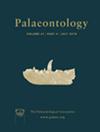基于机器学习的现代银杏和化石银杏叶表皮细胞形态分析及其对古气候研究的影响
IF 2.3
2区 地球科学
Q1 PALEONTOLOGY
引用次数: 0
摘要
叶片气孔是植物组织与大气之间的重要通道,因此是植物与其环境之间的纽带。人们对化石叶片中气孔特性的变化进行了广泛研究,以推断从古生代到新生代的深层时间中的古大气二氧化碳含量。然而,由于叶片表皮细胞形状不规则,人工分析表皮细胞是一项具有挑战性且容易出错的任务,因此它们在重建过去环境方面的作用常常被忽视。在这里,我们利用机器学习(使用从全卷积网络演化而来的 U-Net 架构)自动分割表皮细胞,以有效减少人工误差。此外,我们还利用最小边界矩形从形状不规则的细胞中提取长宽比(RL/W)。我们将这一方法应用于一个数据集,其中包括来自中国三个气候带 16 个地点的 114 片银杏叶中的 21000 多个气孔和 170000 个表皮细胞。我们的结果表明,RL/W 与特定气候参数之间存在负相关,这表明当地的温度和降水条件可能会影响表皮细胞的 RL/W。随后,我们在中国下侏罗世至中侏罗世的 15 个银杏化石上检验了这一方法和现代数据集的观测结果。结果表明,银杏化石的RL/W值通常与现代银杏相似,对较暖的气候背景具有负面响应。对大型古花卉数据集的自动分析为古气候重建提供了新的方向,并强调了银杏表皮细胞隐藏形态特征的重要性。本文章由计算机程序翻译,如有差异,请以英文原文为准。
Machine-learning-based morphological analyses of leaf epidermal cells in modern and fossil ginkgo and their implications for palaeoclimate studies
Leaf stomata form an essential conduit between plant tissue and the atmosphere, thus presenting a link between plants and their environments. Changes in their properties in fossil leaves have been studied widely to infer palaeo-atmospheric-CO2 in deep time, ranging from the Palaeozoic to the Cenozoic. Epidermal cells of leaves, however, have often been neglected for their usefulness in reconstructing past-environments, as their irregular shape makes the manual analyses of epidermal cells a challenging and error-prone task. Here, we used machine-learning (using the U-Net architecture, which evolved from a fully convolutional network) to segment epidermal cells automatically, to efficiently reduce artificial errors. We furthermore applied minimum bounding rectangles to extract length-to-width ratios (RL/W) from the irregularly shaped cells. We applied this to a dataset including over 21 000 stomata and 170 000 epidermal cells in 114 Ginkgo leaves from 16 locations spanning three climate zones in China. Our results show negative correlations between the RL/W and specific climatic parameters, suggesting that local temperature and precipitation conditions may have affected the RL/W of epidermal cells. We subsequently tested this methodology and the observations from the modern dataset on 15 fossil ginkgoaleans from the Lower to the Middle Jurassic (China). It suggested that the RL/W values of fossil ginkgo generally had a similar negative response to warmer climatic backgrounds as modern G. biloba. The automated analyses of large palaeo-floral datasets provide a new direction for palaeoclimate reconstructions and emphasize the importance of hidden morphological characters of epidermal cells in ginkgoaleans.
求助全文
通过发布文献求助,成功后即可免费获取论文全文。
去求助
来源期刊

Palaeontology
地学-古生物学
CiteScore
5.60
自引率
3.80%
发文量
43
审稿时长
6 months
期刊介绍:
Palaeontology publishes a wide variety of papers on palaeontological topics covering:
palaeozoology
palaeobotany
systematic studies
palaeoecology
micropalaeontology
palaeobiogeography
functional morphology
stratigraphy
taxonomy
taphonomy
palaeoenvironmental reconstruction
palaeoclimate analysis and biomineralization studies.
 求助内容:
求助内容: 应助结果提醒方式:
应助结果提醒方式:


